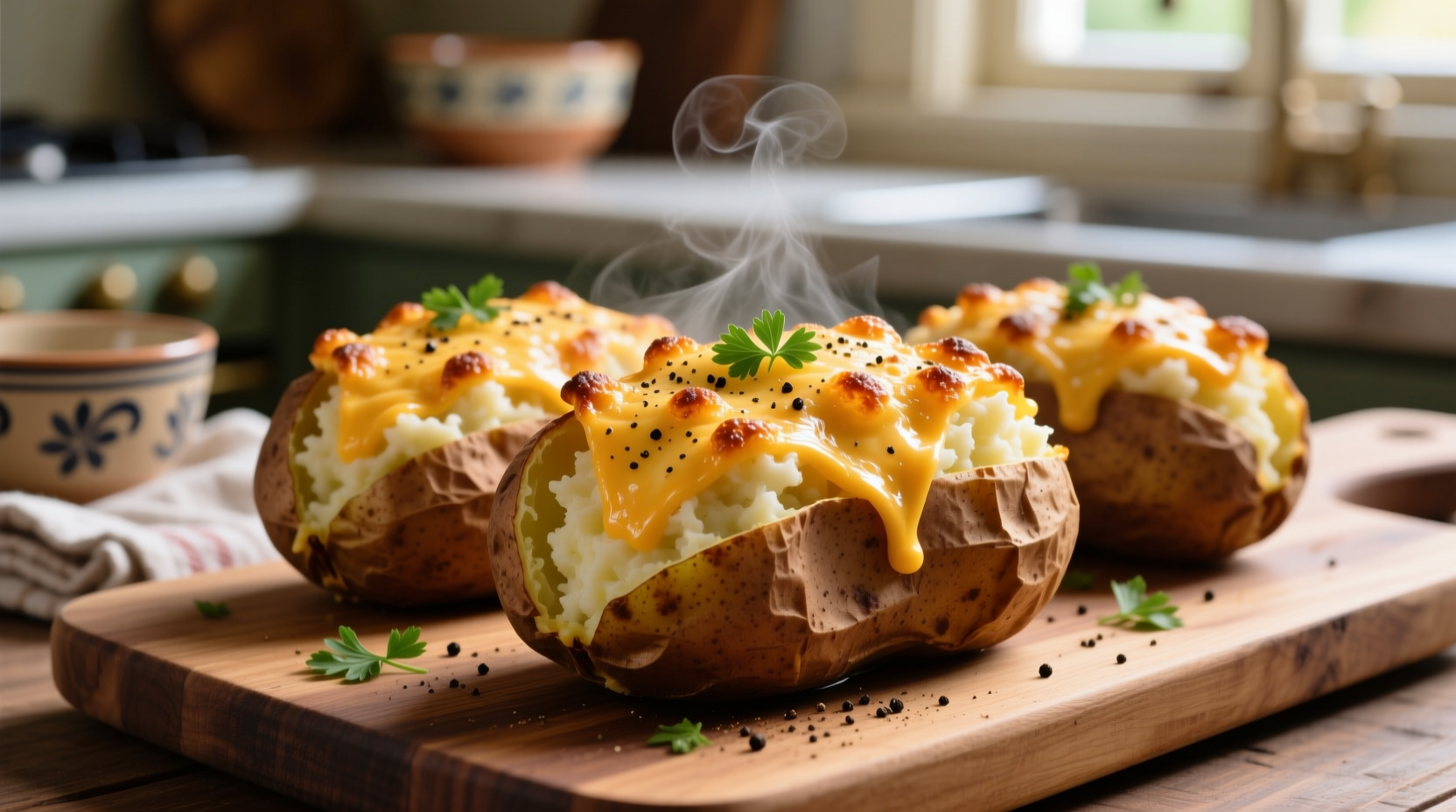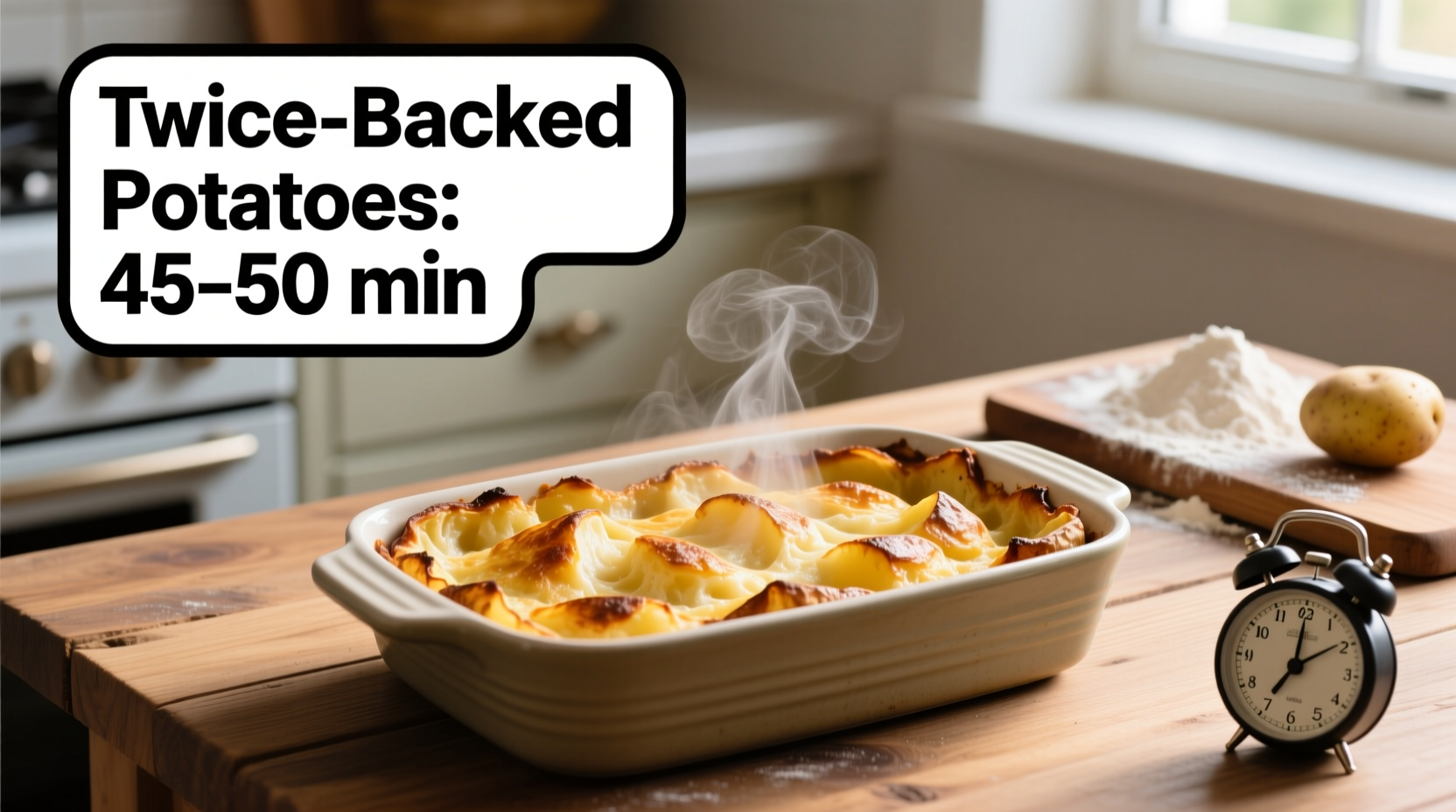Perfectly cooked twice baked potatoes deliver that ideal balance of crispy exterior and creamy interior—but timing mistakes lead to disappointing results. As a chef who's prepared this classic comfort food in professional kitchens and home settings, I've mastered the precise timing variables that transform ordinary spuds into extraordinary side dishes. In this guide, you'll discover not just how long to cook twice baked potatoes, but how to adjust for your specific kitchen conditions, recognize visual doneness cues, and avoid the most common timing pitfalls that even experienced home cooks encounter.
Twice Baked Potato Timeline: From Raw to Ready
Understanding the complete process timeline helps manage expectations and prevents rushed or overcooked results. The journey from raw potato to finished dish involves three distinct phases, each with specific timing requirements:
| Preparation Stage | Time Required | Critical Success Factors |
|---|---|---|
| Initial Potato Baking | 45-60 minutes | Potato size, oven accuracy, proper poking |
| Filling Preparation | 15-20 minutes | Cooling time, ingredient temperature |
| Final Bake | 25-35 minutes | Filling composition, topping type, oven rack position |
Key Variables That Determine Your Exact Cooking Time
While standard timing provides a baseline, these four factors significantly impact how long to cook twice baked potatoes in your specific kitchen:
Potato Size and Type Matter Most
Russet potatoes—the ideal variety for twice baking—behave differently based on size. The USDA Food Safety and Inspection Service confirms that potato density directly affects heat penetration. Their research shows that medium russets (5-8 oz) require approximately 45 minutes at 400°F, while jumbo specimens (10+ oz) need 60-70 minutes for proper internal cooking. Their food safety guidelines specify that potatoes must reach 210°F internally to be fully cooked—a critical threshold often missed when relying solely on time estimates.
Oven Temperature Precision
Professional kitchens consistently use 400°F for optimal twice baked potato results, but home ovens vary significantly. An oven thermometer test conducted by America's Test Kitchen revealed that 30% of home ovens have temperature discrepancies exceeding 25°F. This explains why identical recipes yield different results across kitchens. For consistent outcomes, always verify your oven temperature with a standalone thermometer before baking.
Filling Composition Impact
Cold fillings straight from the refrigerator extend final baking time by 5-10 minutes compared to room-temperature mixtures. Dairy-based fillings (sour cream, cream cheese) require careful monitoring as they can separate if overheated. When adding ingredients like bacon or vegetables, remember that moisture content affects heat transfer—wet ingredients increase baking time while dry toppings like cheese create faster browning.
Altitude Adjustments
At elevations above 3,000 feet, water boils at lower temperatures, requiring extended cooking times. The Colorado State University Extension recommends adding 5-8 minutes per 30 minutes of baking time for high-altitude twice baked potatoes. This adjustment ensures proper starch gelatinization despite reduced atmospheric pressure.
Step-by-Step Timing Guide for Perfect Results
Phase 1: Initial Potato Baking (45-60 minutes)
Start with thoroughly cleaned russets, poked 6-8 times with a fork. Bake directly on the center oven rack at 400°F. Medium potatoes (5-8 oz) need 45-50 minutes, while larger specimens require 55-60 minutes. The perfect twice baked potato cooking time ends when a paring knife inserts with no resistance and internal temperature reaches 210°F. Never skip the temperature check—this prevents undercooked centers that ruin the final product.
Phase 2: Filling Preparation (15-20 minutes)
Allow potatoes to cool for 10 minutes before handling. While they cool, prepare your filling mixture. This cooling period serves two critical purposes: it prevents the filling from becoming watery when mixed with hot potato flesh, and gives dairy ingredients time to reach optimal working temperature. Professional kitchens always bring dairy to room temperature before incorporating—a technique that reduces final baking time by ensuring even heat distribution.
Phase 3: Final Bake (25-35 minutes)
Return filled potatoes to a 375°F oven (reduced from initial temperature to prevent topping burnout). Bake until the edges bubble and toppings achieve golden-brown coloration. For cheese-topped versions, the final 5 minutes at 400°F creates perfect browning without drying the filling. Remember that carryover cooking continues for 5-7 minutes after removal—this explains why many home cooks overbake their twice baked potatoes by pulling them from the oven too late.

Doneness Indicators Beyond the Clock
Relying solely on how long to cook twice baked potatoes leads to inconsistent results. Professional chefs use these three verification methods:
- Internal Temperature Check: 165°F at the filling's center (USDA safe minimum for dairy-containing dishes)
- Visual Texture Test: Toppings should have defined golden edges with slight bubbling at seams
- Sound Indicator: Gentle sizzle when tapped with a spoon during final baking minutes
Troubleshooting Common Timing Issues
Undercooked Centers
If your potatoes remain firm after the recommended twice baked potato cooking time, return them to the oven in 5-minute increments. Cover loosely with foil to prevent topping burnout while the center finishes cooking. This commonly occurs with oversized potatoes or when oven temperatures run low.
Overbrowned Toppings
When toppings brown too quickly but filling remains cool, reduce oven temperature by 25°F and create a foil tent over the potatoes. This technique, used in professional kitchens, allows the filling to heat through without burning the exterior.
Soggy Fillings
Excess moisture in fillings extends baking time and creates texture issues. If your filling appears watery after mixing, bake the potato shells empty for an additional 5-7 minutes before adding filling. This pre-drying step absorbs excess moisture from the potato walls.
Storage and Reheating Timing Guidelines
Properly stored twice baked potatoes maintain quality for 3-4 days in the refrigerator. When reheating, follow these time guidelines:
- Oven method: 20-25 minutes at 350°F (covered for first 15 minutes)
- Convection oven: 15-18 minutes at 325°F
- Skillet method: 8-10 minutes per side over medium heat for crispy exterior
Never microwave twice baked potatoes if you want to preserve texture—the high moisture content creates uneven heating and rubbery results. The optimal reheating approach always depends on your desired texture outcome.











 浙公网安备
33010002000092号
浙公网安备
33010002000092号 浙B2-20120091-4
浙B2-20120091-4